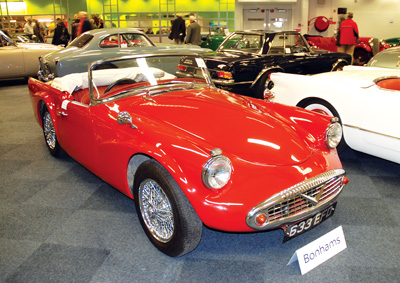
Daimler of the U.K. (no relation to Daimler-Benz) was mainly a purveyor of ultra-stodgy sedans, hearses and limousines to British nobility and the royal family. They were as unlikely an entrant into the sports car market as Kaiser and Nash had been a few years early with the Kaiser-Darrin and the Nash-Healey. Nevertheless, the moribund Daimler saw the export dollars that Standard-Triumph and BMC were raking in during the 1950s, and the company decided to grab their own piece of the pie with the Daimler Dart/SP250.
With no experience in sports car design, it’s natural that Daimler cribbed as much as they could from the people already doing it—stealing liberally from its Coventry neighbor Standard-Triumph and its TR3. The Daimler SP250’s frame, steering and gearbox all are familiar to anyone who has been around a TR3.
For the sake of lower tooling costs, then-revolutionary fiberglass was selected for the coachwork. And while the name of the stylist doesn’t seem to have survived anywhere, it’s a fair bet that he may have been an amateur ichthyologist as the car bears a striking resemblance to a very angry catfish—a phrase immortalized by Publisher Martin in one of his typical off-the-cuff evaluations, this time of the SP250. In fact, he was commenting on the one I owned at the time and was driving on the Colorado Grand. I forgave him as I left him and the Giulia Spider Veloce he was driving in my Daimler dust.
A fantastic engine for a fish
Daimler spent its limited money to good end under the bonnet. Brilliant BSA motorcycle engine designer Edward Turner came up with what should have been one of the greatest sports car engines of all time—a lovely 2.5-liter hemi V8. Aside from four-wheel disc brakes, the rest of the package was technically rather lackluster, including the slow, heavy cam and peg steering and the non-synchro-first four-speed gearbox.
The car was introduced in 1959, and the greatest notice of the event seemed to come from the Chrysler Corporation, which strenuously objected to the use of the name “Dart.” The car was called the SP250 in the United States.
Initial reviews found the car to be fast, with 0-60 mph times in under nine seconds and a legitimate 120 mph top speed—with a ton of torque-derived flexibility that allowed the car to go from puttering at 20 mph in top gear to over 120 mph. Sadly, said flexibility was not limited to the engine—the whippy chassis allowed doors to fly open in turns on bumpy pavement. This, along with the odd styling, did the car few favors in the marketplace.
So-called “B-spec” cars from 1961 on remedied the limbo-dancer flexibility of the chassis. My own B-spec car was admirably free of any cowl shake, but word just never seemed to circulate about the car’s many virtues, which included the aforementioned wonderful engine and really good brakes.
Compared against other 1950s sports cars, the driving experience is quite good. The driving position is pretty standard, with a huge wheel in your chest and rather flimsy seats, but the leather-covered dash, full instrumentation and toggle switches are quite nice. The exhaust note of the little V8 is among the best, sounding curiously like a Ford 289 until about 4,000 rpm, when it takes on a decidedly more exotic shriek—not unlike a Maserati Ghibli.
The 6,300 rpm redline was quite real. Four-wheel disc brakes gave far more stopping power than a Corvette or a Healey of the day, and B-spec cars are quite tight.
A mauling from Jaguar
In 1960, Jaguar bought Daimler for the extra production capacity, and for the aforementioned little V8 which Jaguar continued to use in Daimlers for a number of years. Sir William Lyons was confounded by the SP250, whose looks irked him like fingernails on a chalk board. There was a very pretty styling study called the SP252, but it would have cost about the same as a Jaguar E-type, so it was a non-starter for production. The prototype of this SP252 car survives to this day, but Jaguar wound down production of the SP in 1964 with just over 2,600 built.
Having owned an SP250, I’ve found the angry-catfish looks issue to be overstated. Few observers found my car to be any more hideous than,say, a TR3 (no paragon of grace itself) and the SP250’s fabulous V8, tailpipe symphony, good brakes and rock-solid reliability more than compensated for any shortcomings in the looks department. Because of its build dates, the SP is eligible for some great events. And, for an orphan, the SP250 is very well cared for. Specialists Bryan Purves, David Manners and John Carey can even supply body panels if required.
In terms of collectible status, SP250 proponents are having the last word on detractors—who, incidentally, include Publisher Martin. I sold mine for $26,000 ($10,000 more than I had in it) about six years ago, and Bonhams recently sold one in the U.K. for about $47,000. While this was a strong—and perhaps not immediately repeatable—price, it’s a certainty that nice cars are at least in the mid-$30k range now.
As survivorship appears low—by some estimates around 1,000 cars—it appears that slow and steady appreciation can be expected as long as there are collectors who want something a bit different—but with real performance.